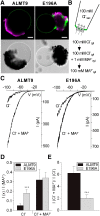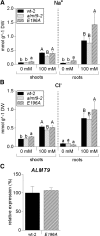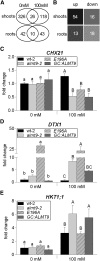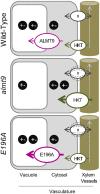Vacuolar Chloride Fluxes Impact Ion Content and Distribution during Early Salinity Stress
- PMID: 27503602
- PMCID: PMC5047071
- DOI: 10.1104/pp.16.00183
Vacuolar Chloride Fluxes Impact Ion Content and Distribution during Early Salinity Stress
Abstract
The ability to control the cytoplasmic environment is a prerequisite for plants to cope with changing environmental conditions. During salt stress, for instance, Na+ and Cl- are sequestered into the vacuole to help maintain cytosolic ion homeostasis and avoid cellular damage. It has been observed that vacuolar ion uptake is tied to fluxes across the plasma membrane. The coordination of both transport processes and relative contribution to plant adaptation, however, is still poorly understood. To investigate the link between vacuolar anion uptake and whole-plant ion distribution during salinity, we used mutants of the only vacuolar Cl- channel described to date: the Arabidopsis (Arabidopsis thaliana) ALMT9. After 24-h NaCl treatment, almt9 knock-out mutants had reduced shoot accumulation of both Cl- and Na+ In contrast, almt9 plants complemented with a mutant variant of ALMT9 that exhibits enhanced channel activity showed higher Cl- and Na+ accumulation. The altered shoot ion contents were not based on differences in transpiration, pointing to a vacuolar function in regulating xylem loading during salinity. In line with this finding, GUS staining demonstrated that ALMT9 is highly expressed in the vasculature of shoots and roots. RNA-seq analysis of almt9 mutants under salinity revealed specific expression profiles of transporters involved in long-distance ion translocation. Taken together, our study uncovers that the capacity of vacuolar Cl- loading in vascular cells plays a crucial role in controlling whole-plant ion movement rapidly after onset of salinity.
© 2016 American Society of Plant Biologists. All Rights Reserved.
Figures







Similar articles
-
The heterotrimeric G-protein β subunit, AGB1, plays multiple roles in the Arabidopsis salinity response.Plant Cell Environ. 2015 Oct;38(10):2143-56. doi: 10.1111/pce.12542. Epub 2015 May 12. Plant Cell Environ. 2015. PMID: 25808946
-
Identification of a Stelar-Localized Transport Protein That Facilitates Root-to-Shoot Transfer of Chloride in Arabidopsis.Plant Physiol. 2016 Feb;170(2):1014-29. doi: 10.1104/pp.15.01163. Epub 2015 Dec 11. Plant Physiol. 2016. PMID: 26662602 Free PMC article.
-
Transgenic salt-tolerant sugar beet (Beta vulgaris L.) constitutively expressing an Arabidopsis thaliana vacuolar Na/H antiporter gene, AtNHX3, accumulates more soluble sugar but less salt in storage roots.Plant Cell Environ. 2008 Sep;31(9):1325-34. doi: 10.1111/j.1365-3040.2008.01838.x. Epub 2008 Jun 3. Plant Cell Environ. 2008. PMID: 18518917
-
Chloride on the Move.Trends Plant Sci. 2017 Mar;22(3):236-248. doi: 10.1016/j.tplants.2016.12.004. Epub 2017 Jan 9. Trends Plant Sci. 2017. PMID: 28081935 Review.
-
Ion Transporters and Abiotic Stress Tolerance in Plants.ISRN Mol Biol. 2012 Jun 3;2012:927436. doi: 10.5402/2012/927436. eCollection 2012. ISRN Mol Biol. 2012. PMID: 27398240 Free PMC article. Review.
Cited by
-
Multiple ALMT subunits combine to form functional anion channels: A case study for rice ALMT7.Front Plant Sci. 2022 Nov 14;13:1012578. doi: 10.3389/fpls.2022.1012578. eCollection 2022. Front Plant Sci. 2022. PMID: 36452104 Free PMC article.
-
The Importance of Cl- Exclusion and Vacuolar Cl- Sequestration: Revisiting the Role of Cl- Transport in Plant Salt Tolerance.Front Plant Sci. 2019 Nov 8;10:1418. doi: 10.3389/fpls.2019.01418. eCollection 2019. Front Plant Sci. 2019. PMID: 31781141 Free PMC article. Review.
-
Ion Transport at the Vacuole during Stomatal Movements.Plant Physiol. 2017 Jun;174(2):520-530. doi: 10.1104/pp.17.00130. Epub 2017 Apr 5. Plant Physiol. 2017. PMID: 28381500 Free PMC article. Review.
-
Role of Acetic Acid and Nitric Oxide against Salinity and Lithium Stress in Canola (Brassica napus L.).Plants (Basel). 2023 Dec 22;13(1):51. doi: 10.3390/plants13010051. Plants (Basel). 2023. PMID: 38202358 Free PMC article.
-
ABA-Induced Stomatal Closure Involves ALMT4, a Phosphorylation-Dependent Vacuolar Anion Channel of Arabidopsis.Plant Cell. 2017 Oct;29(10):2552-2569. doi: 10.1105/tpc.17.00452. Epub 2017 Sep 5. Plant Cell. 2017. PMID: 28874508 Free PMC article.
References
-
- Abramoff MD, Magalhaes PJ, Ram SJ (2004) Image processing with ImageJ. Biophotonics International 11: 36–42
-
- Arrivault S, Senger T, Krämer U (2006) The Arabidopsis metal tolerance protein AtMTP3 maintains metal homeostasis by mediating Zn exclusion from the shoot under Fe deficiency and Zn oversupply. Plant J 46: 861–879 - PubMed
-
- Barbier-Brygoo H, De Angeli A, Filleur S, Frachisse JM, Gambale F, Thomine S, Wege S (2011) Anion channels/transporters in plants: from molecular bases to regulatory networks. Annu Rev Plant Biol 62: 25–51 - PubMed
Publication types
MeSH terms
Substances
LinkOut - more resources
Full Text Sources
Other Literature Sources
Molecular Biology Databases

